#cat behaviors
Explore tagged Tumblr posts
Text

We haven't put our laundry away yet, so Spoons has been hard at work bringing us every sock from the pile.
It's a lot to handle but somebody's got to move these socks around
619 notes
·
View notes
Text

He is so orange
#brick collector#personal blog#tugboat the cat#him doing this stressed me out so much#he is so good though#tugboat#orange cat#orange cat behavior#cat#cats of tumblr#Orange cats of tumblr
16K notes
·
View notes
Text

Mom found this while she was cleaning up some papers from who-knows-where; I told her it was the kind of thing that would do numbers on the internet, and she told me to go ahead and post it. Transcript follows:
Two Kittens If you were a kitten, how would you play? Sneak up, pounce! Then run away! If I was another, what would I do? Roll over, jump up! Then, chase after you! If we were two kittens, how would it end? I got you, I caught you! Now, please be my friend. by Beth Bylander
3K notes
·
View notes
Text

I…don’t think that’s possible right now…
#cats#cats of tumblr#cute cats#cats pics#beautiful cats#meow#my photography#purrfection#animals#thecatcrew#buttercup#funny content#funny post#apple watch#calico cat#calico#good morning#girl cat#happy cat#sleepy cat#cat people#cat house#caturday#cat#cat blog#cat lovers#catnap#peaceful#cat behavior#cat content
8K notes
·
View notes
Text
I promised you some lions! Let's talk about manes, males, and management.
This is Tandie, the current male lion at the Woodland Park Zoo.
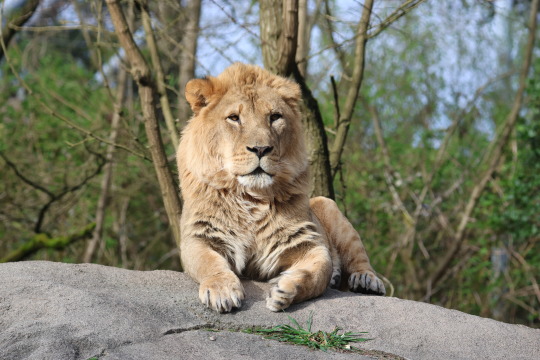
Notice anything odd about him? He's got one of those hilarious awkward teenager manes. Except... this cat is nine years old.
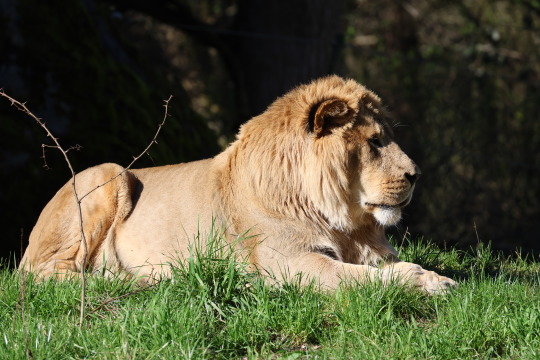
I was, of course, immediately curious.
Manes serve a lot of purposes for male lions, including being an indicator of health and fitness - it's actually a sexually selected trait and a social signal. Mane texture / hair quality / length is dependent on nutrition and the body having energy to grow (and carry around!) that much hair! The color is also a signal: males with darker manes have been found to have higher testosterone levels.
In one research report, wild males were much more likely to avoid a lion decoy when it had a longer or darker mane - but the girls really loved a dark mane. It's thought this is because a long, dark mane is an indicator of mate quality. Males with longer, darker manes have higher testosterone and were pretty healthy: meaning they had more energy for fighting, had a better chance of recovering if they got injured, and generally had a higher rate of offspring survival. Manes matter!
So, back to Tandie. He was actually born at the Woodland Park Zoo in 2014 alongside two brothers, to dad Xerxes and mother Adia.
This was Xerxes (rip).
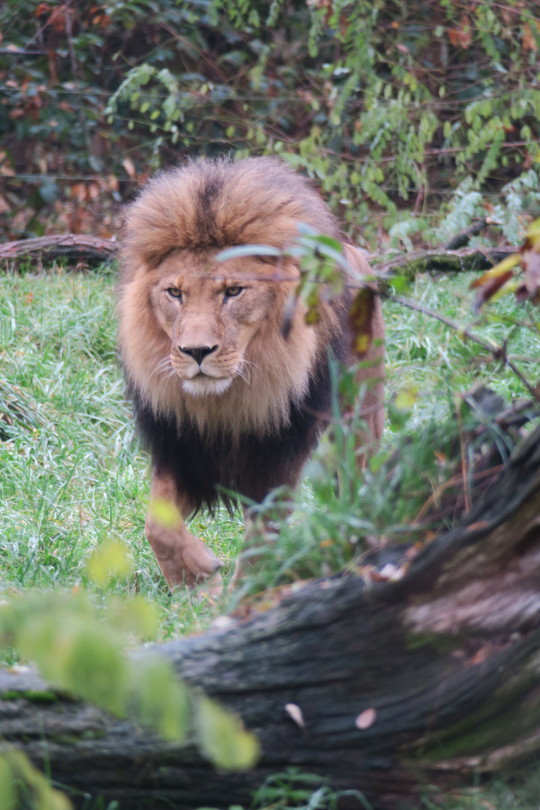
Obviously, a very large, dark, lush mane on Xerxes here. So where did these blond muttonchops come from on his son?
I asked the zoo docents and got an answer that didn't make a lot of sense. They told me that after the three cubs grew into adolescents, they were moved to the Oakland Zoo together. But living together suppressed his testosterone, and he never grew a mane.
Hmmmm.
Here's a photo from 2016, when the brothers debuted at Oakland. They're a year and a half old in this photo.
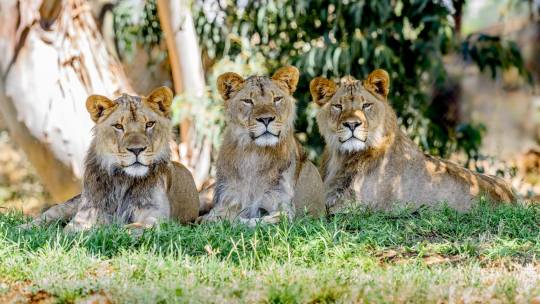
(Photo Credit: Oakland Zoo)
And here's from an announcement for their third birthday.

(Photo credit: Oakland Zoo)
Okay, so these dudes obviously all were growing manes as of 2017. I think Tandie is the one on the left in the first photo, and laying down in the middle on the second. What happened?
I was just in the Bay Area for a zoo road trip, of course I went to Oakland and tracked down a docent to ask some questions.
It turns out that shortly after the brothers turned three, they started acting like adult male lions: they started scuffling regularly. It's a normal social thing for male lions to live in groups, called coalitions, but according to my lion experts there's generally a baseline level of some social jostling within them. It wasn't quite clear from what the docent said if they couldn't manage the boys together, or if they just wanted to avoid the scratches and small wounds that result from normal lion behavior. Regardless, they put all three of the boys on testosterone blockers in order to be able to keep them together as a social group.
Now, I don't know a lot about the use of hormone alteration as a form of captive animal management, except in the case of birth control. I don't think it's something that's unethical - there was just a webinar on it that I saw go by - but I don't think it's commonly done with big cats. Lions have kind of complicated reproductive cycles, and for instance, we've been learning that female lions can take much longer to come into estrus again than expected after coming off hormonal birth control.
In males, testosterone blockers (or being neutered) means they lose their manes. This is why a lot of rescues will do a vasectomy on their males instead of a neuter - it allows them to keep their mane and the social signals that accompany it.
Tandie returned home to Woodland Park Zoo after Xerxes passed in early 2022, and the docent told me all of the lions had been off their blockers "for while." I'd guess those things happened around the same time, since bringing the trio down to a duo at Oakland would reduce some of the social tensions.
Hormones are such interesting things, though. One of Tandie's brothers has a full mane again, and the other is still totally mane-less.

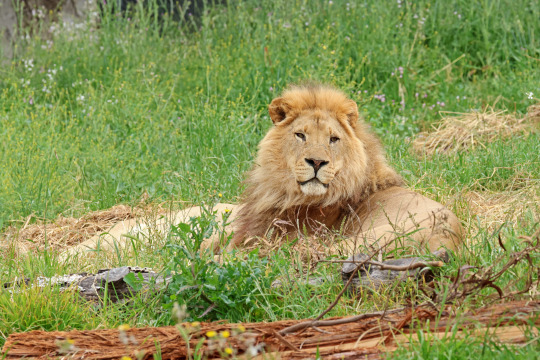
As for Tandie, his mane is growing back in, and it looks like he might rival his dad for length and coloration.
He started here, in February:
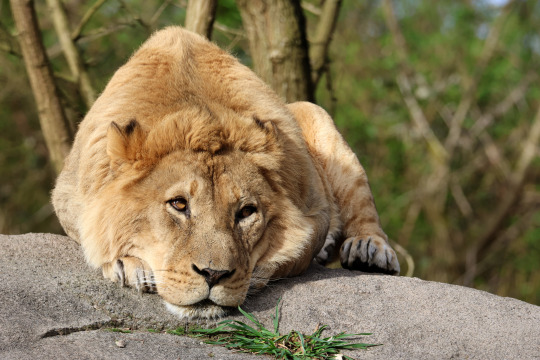
Yesterday:
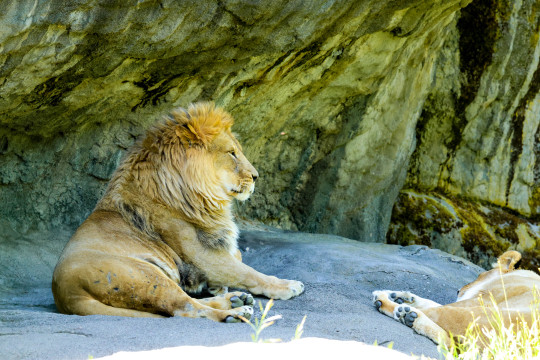
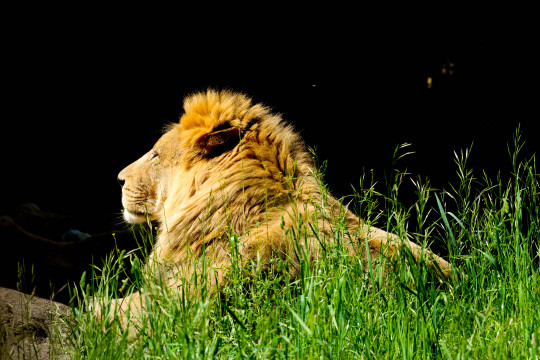
What a difference four months (and maybe proximity to a girl) makes!
#big cats#lion#african lion#big cat behavior#zoo animals#zoo animal welfare#captive animal management#zoos
8K notes
·
View notes
Text
Imagine you were roommates with someone who didn’t speak your language. And like. You guys are best friends, you love your roommate so much. You hang out all the time and it’s great.
But sometimes when you go to scratch an itch they suddenly get so upset. Like they’ll yell or clap or make weird sounds. You have no idea why because you’re itchy. You gotta scratch the itch! But it makes them so upset that you only scratch itches when they aren’t around.
Otherwise stuff is fine, they feed you and you’re happy living with them. You play games and stuff and even though you don’t speak the same language you both have a lot of fun. It’s just that sometimes they’ll burst out for no reason and you just get to deal with it.
That’s basically what it’s like for our pets, I think.
#ramblies#just saw a video of cats getting ‘caught’ being naughty#and they freeze and I’m like yeah you trained them that you’d have an outburst they don’t enjoy from the behavior#but they obviously still do it when you aren’t watching#cats#animal behavior
4K notes
·
View notes
Text
A study that just came out demonstrates that outdoor cats are known to prey on over two thousands species of wild animal, from mammals to birds to insects. That includes 347 species that are endangered, threatened or otherwise of concern, and they've been a key factor of the permanent extinction of over 60 species. And while cats may not always bring home what they catch, chances are if your cat is allowed to roam unsupervised outside, they're killing your local wildlife.
Why is this so important? Worldwide, wild animal populations have decreased in number by 69% in the past fifty years; that means that in my lifetime (born in 1978), the sheer number of wild animals in the world has been decreased by over half. Even "common" wild species are less numerous than before. While habitat population is the single biggest cause of species endangerment and extinction overall, outdoor and indoor/outdoor cats are a significant cause as well. In fact, they are the single biggest cause of human-caused mortality in wild birds.
Most importantly, it's very, very simple to fix this problem: keep your cats indoors, and spay and neuter them. If your cat is bored, they need more enrichment, and there are plenty of ways to make your home more exciting for them, from bringing home cardboard boxes for them to explore, to playing with them more often. If you want your cat to get some outdoor enrichment, leash train them (yes, it can be done!) If you have the space and resources, build them a catio where they can be safe from outdoor dangers like predators and cars, while also keeping local wildlife safe from them.
If you just give into their whining and pawing at the door, then they know that that's what they have to do to get their way; I know it's a tough transition, but it's worth it in the end for everyone involved. Cats are domesticated, which means they are not native anywhere in the world; there are exactly zero ecosystems in which they belong, save for the safety of your home. It is your responsibility to give them an enriching environment without taking the shortcut of letting them go wreak havoc outside.
#cats#outdoor cats#feral cats#nature#wildlife#animals#ecology#environment#conservation#science#scicomm#birds#endangered species#extinction#domesticated animals#domestication#biology#animal behavior#animal welfare
8K notes
·
View notes
Text
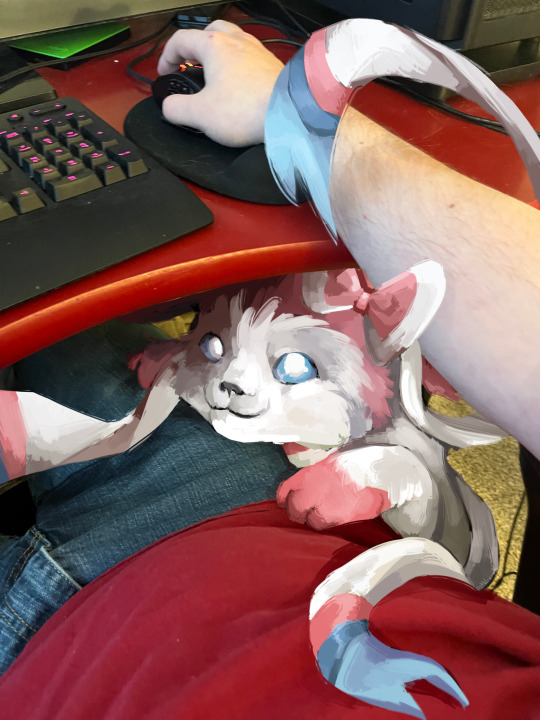
@realpokemon
Someone wants attention.
Vivi you aren’t a lap Eevee anymore and haven’t been one for like 9 years. Stop. :p
#pokemon#pkmn irl#unreality#pokemon irl#sylveon#Vivi the sylveon#he’s all scrunched under the desk#wants the uppies#art by realpokemon#eeveelution#based on my irl cat behavior of squeezing her gotdang head between my leg and the desk to try and get up
9K notes
·
View notes
Text





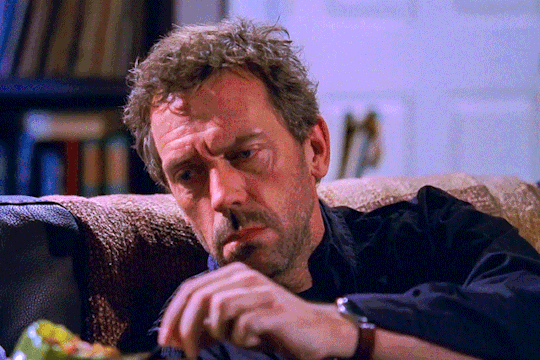




wilson knew house would mooch his food so he already prepared a spoon for him before house does anything
#house md#house#hilson#gregory house#greg house#james wilson#robert sean leonard#rsl#hugh laurie#s02e15#and its wilson wednesday!#wilson love him so much#cat behavior#i mean house
2K notes
·
View notes
Photo

The ancestor of all domestic cats is the African Wild Cat which still exists today.
#facts about cats#cats of tumblrcat facts#cats#black cats facts#facts#facts about cats for kids#kitten facts#male cat facts#cat facts video#black cat facts#cat tips and facts#cat facts mind blowing#fun facts about cats#cool facts about cats#facts about female cats#amazing facts about cats#6 facts about female cats#facts about cats behavior#cats 101#interesting facts about cats#black cats surprising facts#amazing facts about black cats
2K notes
·
View notes
Text
also reworked these iconic gals



2K notes
·
View notes
Text



She bopped you. She bopped you TWICE and you were trying to get away???
#house of the dragon#hotd#hotd spoilers#that's cat behavior you can't tell me otherwise asjdnskskjajaja#hotd season 2#silverwing#ulf white#house of the dragon season 2
2K notes
·
View notes
Text
Additional comment from the submitter: ❝my friend who owns a cat says you can’t be a cat owner without getting scratched or bitten by the cat at least once. I don’t think she’s a “bad owner” just because her cat sometimes playfully bites and scratches her, obviously she’s never abused the cat (I strongly believe she loves and has never mistreated her pets), she does give him some discipline but still gets scratched and bitten from time to time (not all the time). So I think it’s just in cats’ nature (cats being cats)? But I’d love to hear other owners’ experiences since I obviously am not a cat expert.❞
This poll was submitted to us and we simply posted it so people could vote and discuss their opinions on the matter. If you’d like for us to ask the internet a question for you, feel free to drop the poll of your choice in our inbox and we’ll post them anonymously (for more info, please check our pinned post).
#cat#cats#animals#pet#pets#animal behavior#cat owner#cat owners#poll#polls#tumblr polls#tumblr poll#incognito polls#poll time#random polls#fun polls
1K notes
·
View notes
Note
hello! I was scrolling through your blog (delightful) and found the post about Beef and his whiskers position, and I'm ashamed to say that in all my near-thirty years of being around cats and thinking I understand them pretty well I never thought to pay attention to the 'circle shape'. could you please expound a bit on what to look for when it comes to whiskers position and how to interpret it? Beef is an absolute sweetheart but looking at a brachy cat as an example makes it a bit hard for me to generalize. thank you!
Thank you! And also thank you for your patience--- I wanted to give some really good examples and have been scouring my blog for the best circle whisker cats I could find.
Picture heavy post under this.

so this is the cat grimace scale. It's a sort of way to visually see if a cat is in pain/distress, and it gives a simplified view of the things I'm going to discuss. It's important to recognize that whisker shape/position is just ONE piece of communication and doesn't tell the whole story. A lot of this is also based on CONTEXT as well.
When you're looking at a cat face, here are the things you really want to pay attention to:
Ear position—Ears facing forward, ears slightly pulled apart, or ears flattened and rotated outward.
Orbital tightening—Eyes opened, eyes partially opened, or eyes squinted.
Muzzle tension—Muzzle relaxed (round), muzzle mildly tense, or muzzle tense (elliptical).
Whisker position—Whiskers loose and curved, whiskers slightly curved or straight, or whiskers straight and moving forward.
Head position—Head above the shoulder line, head aligned with the shoulder line, or head below the shoulder line or tilted.

Calypso's huge whiskers give a REALLY good visual on the 'circle shape' to look for. You can see her whiskers are pushed forward and are loose and curved. She's feeling playful and engaged! She really wants to know what I'm up to and what's in my hand (spoiler alert, it was treats)
Compare that to this later picture, taken after she heard a dog bark nearby:

Her muzzle is tighter. Her whiskers are pulled back a bit, and are straight. Her ears are set differently as well, one pulled back a bit. She's concerned, but not terribly worried about this strange sound.
You can also compare it to this handsome lad:

Again, his whiskers are fairly straight. They aren't pulled back as far, but he's still very tense. He was extremely tense and upset that I took his water dish away from him (because it needed to be cleaned and changed).
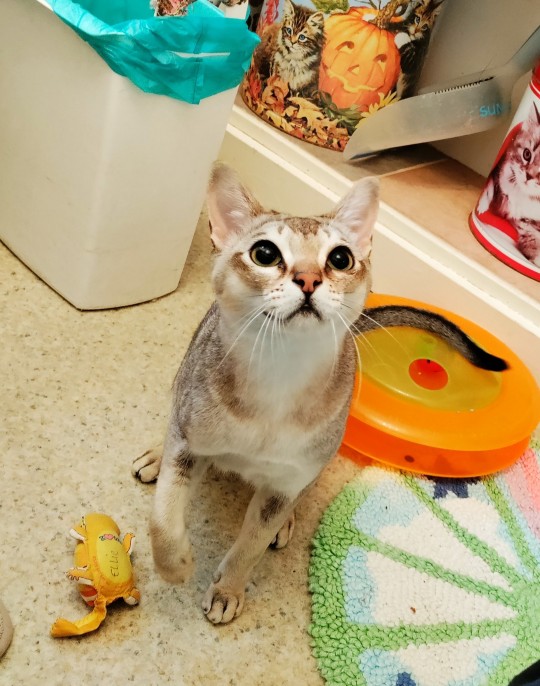
Milo is another great example of excited whiskers. They're pushed forward and curved, forming a sort of circle. Like Calypso, he's interested in what I'm doing and feeling playful. He was very interested in the toy I was throwing for him.
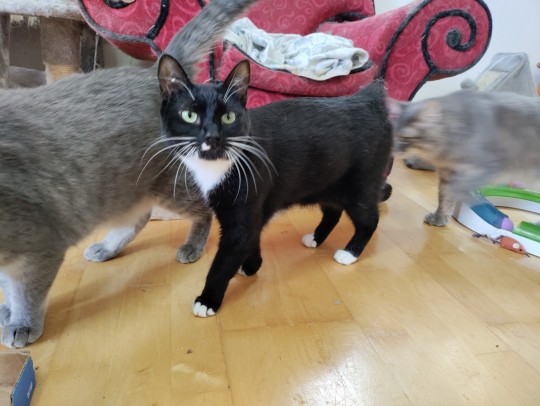
Gumdrop is a good example of a more relaxed whisker position. She's curious, but not feeling playful. Her whiskers are held very loosely rather than being pushed forward. Her tail nub is up, indicating friendliness and confidence.
2K notes
·
View notes
Text
I’m seeing an uptick in “begging scam asks” that are profiting from people’s generosity towards evacuees from Gaza. I’m happy to boost vetted/verified fundraisers, but I do not respond to fundraising asks.
2K notes
·
View notes
